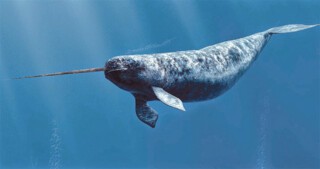In 1584 , as Ivan the Terrible lay dying, he called from his bed for his unicorn horn, a royal staff ‘garnished with verie fare diamondes, rubies, saphiers, emeralls’. Unicorn horns were believed throughout Europe to have magical curative properties; as late as 1789, a unicorn drinking horn was used to protect the French court, where it was said to sweat and change colour in the presence of poison. To prove the horn’s efficacy, Ivan ordered his physician to scratch a circle on the table with the tip of the horn, and to ‘seeke owt for som spiders’. The spiders placed within the circle curled up and died; spiders placed outside it ran away and survived. The dead spiders, though, could not console Ivan. ‘It is too laite,’ he said, ‘it will not preserve me,’ whereupon, soon afterwards, he died.
The unicorn horn was, of course, a narwhal tusk: the tooth of a small Arctic whale, which grows out through the upper lip, twisting counter-clockwise for up to 2.5 metres. Named rather ungallantly for the Old Norse word nar, meaning ‘corpse’, and hvalr, ‘whale’, after their mottled grey markings, narwhals are unicorn-like not just in their appendages, but in their elusiveness; they are one of the mammals about which we know least. They spend the winter months dodging dense pack ice, where humans cannot follow, and can swim a mile deep, twisting upside-down as they descend into pitch-black water.
The great mystery of the narwhal is the purpose of its tusk. Appearing in males of about a year old, as short and thin as a little finger, it grows for nearly ten years until it’s as wide as 25 cm at the base. Herman Melville writes of the ‘nostril whale’ in Moby-Dick: ‘Some sailors tell me that the Narwhale employs it for a rake in turning over the bottom of the sea for food. Charley Coffin said it was used for an ice-piercer … But you cannot prove either of these surmises to be correct.’ He ends by suggesting it would make an excellent letter opener. Because less than 15 per cent of female narwhals have the tusk, it can’t be necessary for survival, and so, when male narwhals were observed clashing tusks it was often interpreted as rivalrous jousting. Recently, though, scientists have found that the tusk is shot through with around ten million nerve endings, and by rubbing tusks on meeting, the narwhals may be passing on information about the salinity (and therefore propensity to freeze) of the water through which they have just passed; not aggressors, then, but Mercators. The horns may also be an aid to courtship; a positive correlation has been discovered between testicle size and horn length, and the tusk may be a way for the most fertile male narwhals to advertise themselves.
The narwhal is exquisitely formed. To conserve heat, the surface area of its skin is as streamlined as possible: no ears, no lips, no eyelashes, no inconveniently extruding sexual organs; nothing to hold back the swift passage through water. As much as 40 per cent of the narwhal’s body mass can be made up of blubber, allowing it to keep a warm mammalian body temperature amid the dark floating ice. Narwhals mate in a kind of ballet; a pair will swim alongside each other for hours, skins touching, until the female twists belly up to press her body against the male. Later, when the female narwhal gives birth, an adolescent female from the pod will frequently act as nursemaid, swimming beside the mother with the calf between them to create a current that sweeps the baby along, the whale equivalent of a papoose.
The legend of the narwhal is not a gentle one. The Danish ethnologist Knud Rasmussen recorded the myths of the Inuit of Greenland’s northwestern coast in the late 19th century. In the narwhal origin myth, the cruel mother of a blind son tricks him out of his fair share of bear meat. The mother plaits and twists her hair into a long braid and the two go out to harvest passing white whales; the son binds her with ropes to one of the whales, and it drags her into the sea. According to Rasmussen, ‘she did not come back, and was changed into a narwhal … and from her the narwhals are descended.’
One of the earliest written accounts of the narwhal dates from 1577. Martin Frobisher, seaman and privateer, led an expedition to Baffin Island, where his men discovered a dead narwhal on the beach. They tested it for magic, using the same method as Ivan the Terrible:
On this West shoare we found a dead fishe floating, whiche had in his nose a horne streight and torquet, of lengthe two yardes lacking two ynches, being broken in the top, where we might perceiue it hollowe, into which some of our Saylers putting Spiders, they presently dyed. I sawe not the tryall hereof, but it was reported vnto me of a trueth: by the vertue whereof, we supposed it to be a sea Unicorne.
Triumphantly, they took the horn. They also forcibly took three Inuit from their homes: a man, Calichough; a woman, Egnock; and her child, Nutioc. All of them died soon after arriving in England. According to Moby-Dick, ‘when Sir Martin returned from that voyage … he presented to her highness a prodigious long horn of the Narwhale, which for a long period after hung in the castle at Windsor.’
This was not Elizabeth I’s only narwhal tusk. Sir Humphrey Gilbert, Walter Raleigh’s half-brother, presented her with a gem-encrusted narwhal tusk worth £10,000 (enough, at the time, to buy and staff a small castle). It was, he told her, a ‘sea-unicorn’. Gilbert’s Latin motto was Quid Non (‘Why not?’) but in this instance he probably believed himself to be truthful; unicorns, after all, appear nine times in the Bible.
Narwhals are designated ‘near threatened’. The greatest threat to their survival is climate change, which is shrinking the ice cover too quickly for them to adapt; without ice cover they will have nowhere to hide from killer whales, nowhere to feed. Narwhals communicate via a series of clicks and buzzes (higher in pitch than a humpback whale’s, less shrill than a dolphin’s); with increased shipping and industrial extraction in the Arctic, noise pollution risks rendering them inaudible and effectively mute, and thereby unable to protect and teach their young. For now, though, there are perhaps eighty thousand in existence. The Arctic is currently in its polar night. In some corner of the sunless sea, passing through waters cold and dark enough to keep us at bay, there is beauty and strangeness that rivals the unicorn.
Send Letters To:
The Editor
London Review of Books,
28 Little Russell Street
London, WC1A 2HN
letters@lrb.co.uk
Please include name, address, and a telephone number.


